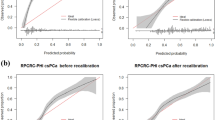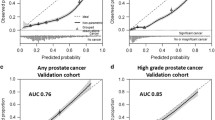Abstract
Purpose
To externally validate the clinical utility of Chinese Prostate Cancer Consortium Risk Calculator (CPCC-RC) and Asian adapted Rotterdam European Randomized Study of Screening for Prostate Cancer Risk Calculator 3 (A-ERSPC-RC3) for prediction prostate cancer (PCa) and high-grade prostate cancer (HGPCa, Gleason Score ≥ 3 + 4) in both Chinese and European populations.
Materials and methods
The Chinese clinical cohort, the European population-based screening cohort, and the European clinical cohort included 2,508, 3,616 and 617 prostate biopsy-naive men, respectively. The area under the receiver operating characteristic curve (AUC), calibration plot and decision curve analyses were applied in the analysis.
Results
The CPCC-RC’s predictive ability for any PCa (AUC 0.77, 95% CI 0.75–0.79) was lower than the A-ERSPC-RC3 (AUC 0.79, 95% CI 0.77–0.81) in the European screening cohort (p < 0.001), but similar for HGPCa (p = 0.24). The CPCC-RC showed lower predictive accuracy for any PCa (AUC 0.65, 95% CI 0.61–0.70), but acceptable predictive accuracy for HGPCa (AUC 0.73, 95% CI 0.69–0.77) in the European clinical cohort. The A-ERSPC-RC3 showed an AUC of 0.74 (95% CI 0.72–0.76) in predicting any PCa, and a similar AUC of 0.74 (95% CI 0.72–0.76) in predicting HGPCa in Chinese cohort. In the Chinese population, decision curve analysis revealed a higher net benefit for CPCC-RC than A-ERSPC-RC3, while in the European screening and clinical cohorts, the net benefit was higher for A-ERSPC-RC3.
Conclusions
The A-ERSPC-RC3 accurately predict the prostate biopsy in a contemporary Chinese multi-center clinical cohort. The CPCC-RC can predict accurately in a population-based screening cohort, but not in the European clinical cohort.


Similar content being viewed by others
References
Siegel RL, Miller KD, Jemal A (2015) Cancer statistics, 2015. CA Cancer J Clin 65:5
Torre LA, Bray F, Siegel RL et al (2015) Global cancer statistics, 2012. CA Cancer J Clin 65:87
Chen R, Ren S, Yiu MK et al (2014) Prostate cancer in Asia: a collaborative report. Asian Journal of Urology 1:15
Kitagawa Y, Namiki M (2015) Prostate-specific antigen-based population screening for prostate cancer: current status in Japan and future perspective in Asia. Asian J Androl 17:475
Roobol MJ, Steyerberg EW, Kranse R et al (2010) A risk-based strategy improves prostate-specific antigen-driven detection of prostate cancer. Eur Urol 57:79
Chen R, Sjoberg DD, Huang Y et al (2017) Prostate specific antigen and prostate cancer in Chinese men undergoing initial prostate biopsies compared with western cohorts: data from the PBCG and CPCC. J Urol 197:90–96
Roobol MJ, Verbeek JFM, van der Kwast T et al (2017) Improving the Rotterdam European Randomized Study of Screening for Prostate Cancer Risk Calculator for Initial Prostate Biopsy by Incorporating the 2014 International Society of Urological Pathology Gleason Grading and Cribriform growth. Eur Urol 72:45
Yoon DK, Park JY, Yoon S et al (2012) Can the prostate risk calculator based on Western population be applied to Asian population? Prostate 72:721
Zhu Y, Wang JY, Shen YJ et al (2012) External validation of the Prostate Cancer Prevention Trial and the European Randomized Study of Screening for Prostate Cancer risk calculators in a Chinese cohort. Asian J Androl 14:738
Chen R, Xie L, Xue W et al (2016) Development and external multicenter validation of Chinese Prostate Cancer Consortium prostate cancer risk calculator for initial prostate biopsy. Urol Oncol 34:416 e1
Chiu PK, Roobol MJ, Nieboer D et al (2017) Adaptation and external validation of the European randomised study of screening for prostate cancer risk calculator for the Chinese population. Prostate Cancer Prostatic Dis 20:99
van Buuren S, Groothuis-Oudshoorn CGM (2011) Multivariate imputation by chained equations in R. J Stat Softw 45:1
Roobol MJ, van Vugt HA, Loeb S et al (2012) Prediction of prostate cancer risk: the role of prostate volume and digital rectal examination in the ERSPC risk calculators. Eur Urol 61:577
Gleason DF, Mellinger GT (1974) Prediction of prognosis for prostatic adenocarcinoma by combined histological grading and clinical staging. J Urol 111:58
Humphrey PA (2004) Gleason grading and prognostic factors in carcinoma of the prostate. Mod Pathol 17:292
Chiu PK, Roobol MJ, Nieboer D et al (2016) Adaptation and external validation of the European randomised study of screening for prostate cancer risk calculator for the Chinese population. Prostate Cancer Prostatic Dis 20:99–104
Ankerst DP, Straubinger J, Selig K et al (2018) A Contemporary prostate biopsy risk calculator based on multiple heterogeneous cohorts. Eur Urol 74:197
Wu YS, Zhang N, Liu SH et al (2016) The Huashan risk calculators performed better in prediction of prostate cancer in Chinese population: a training study followed by a validation study. Asian J Androl 18:925
Park JY, Yoon S, Park MS et al (2017) Development and external validation of the Korean Prostate Cancer Risk Calculator for High-Grade Prostate Cancer: comparison with two Western Risk Calculators in an Asian Cohort. PLoS ONE 12:e0168917
Park JY, Yoon S, Park MS et al (2011) Initial biopsy outcome prediction in Korean patients-comparison of a noble web-based Korean prostate cancer risk calculator versus prostate-specific antigen testing. J Korean Med Sci 26:85
Suzuki H, Komiya A, Kamiya N et al (2006) Development of a nomogram to predict probability of positive initial prostate biopsy among Japanese patients. Urology 67:131
Loeb S, Bruinsma SM, Nicholson J et al (2015) Active surveillance for prostate cancer: a systematic review of clinicopathologic variables and biomarkers for risk stratification. Eur Urol 67:619
Vedder MM, de Bekker-Grob EW, Lilja HG et al (2014) The added value of percentage of free to total prostate-specific antigen, PCA3, and a kallikrein panel to the ERSPC risk calculator for prostate cancer in prescreened men. Eur Urol 66:1109
Osses DF, Roobol MJ, Schoots IG (2019) Prediction medicine: biomarkers, risk calculators and magnetic resonance imaging as risk stratification tools in prostate cancer diagnosis. Int J Mol Sci. https://doi.org/10.3390/ijms20071637
Acknowledgements
This study is supported by National Natural Science Foundation Youth Project (Rui Chen, 81702514). We give our sincere gratitude to Chinese Prostate Cancer Consortium, and Prof. Wei Xue (Renji Hospital, Shanghai Jiao Tong University, School of Medicine), Prof. Liping Xie (First Affiliated Hospital, School of Medicine, Zhejiang University, Hangzhou), Prof. Liqun Zhou, (Peking University First Hospital, Institute of Urology, Peking University, National Urological Cancer Center, Beijing) for collecting the biopsy data.
Author information
Authors and Affiliations
Contributions
RC: protocol/project development, data collection or management, manuscript writing/editing. JMV: protocol/project development, data collection or management, data analysis, manuscript writing/editing. YY: data collection or management, manuscript editing. ZS: data collection or management, manuscript editing. YS: protocol/project development. MJR: protocol/project development.
Corresponding authors
Ethics declarations
Conflict of interest
The authors have no potential conflicts of interest to disclose.
Research involving human participants
This study is approved by Ethical review board of Changhai Hospital.
Additional information
Publisher's Note
Springer Nature remains neutral with regard to jurisdictional claims in published maps and institutional affiliations.
Rights and permissions
About this article
Cite this article
Chen, R., Verbeek, J.F.M., Yang, Y. et al. Comparing the prediction of prostate biopsy outcome using the Chinese Prostate Cancer Consortium (CPCC) Risk Calculator and the Asian adapted Rotterdam European Randomized Study of Screening for Prostate Cancer (ERSPC) Risk Calculator in Chinese and European men. World J Urol 39, 73–80 (2021). https://doi.org/10.1007/s00345-020-03177-0
Received:
Accepted:
Published:
Issue Date:
DOI: https://doi.org/10.1007/s00345-020-03177-0




